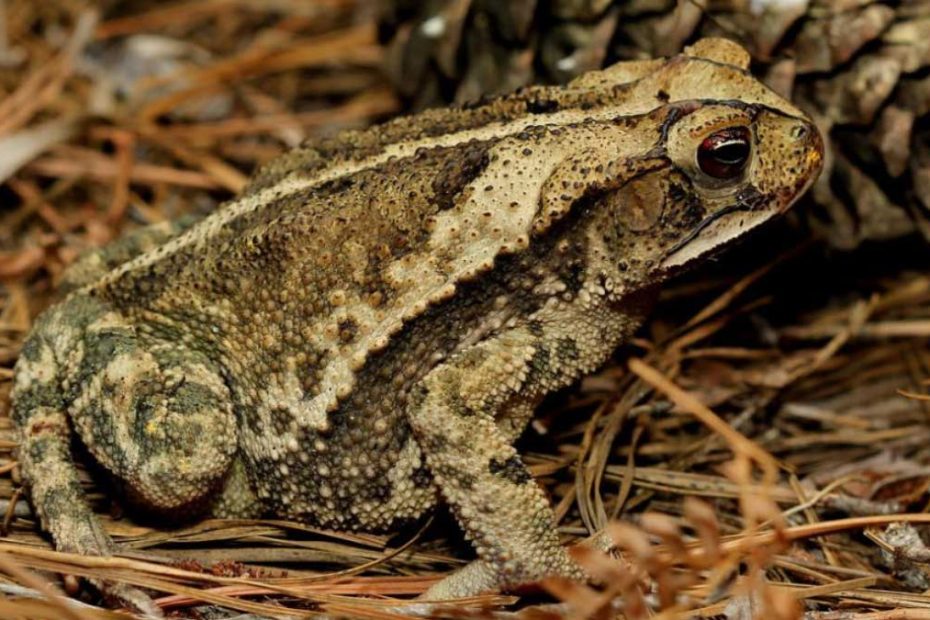The Gulf Coast toad (Incilius valliceps) is one of the largest species native to the southeastern United States—adults grow up to 5 inches. Probably the most unique feature of this toad is the prominent cranial ridges resting on top of its skull. These set it apart from other toads. This toad species is highly adaptable and occurs in a variety of moist and warm habitats throughout its range, including in urban settings.
In this article, we’ll delve into the world of the Gulf Coast toad, exploring its unique characteristics and behaviors. We will uncover the secrets behind its physical size, male vs female differences, and share details of its varied diet. Additionally, we will explore its poisonous characteristics and the risk it poses to other creatures, including dogs. We’ll also discuss the toad’s longevity and availability in the pet trade.
An Overview of the Gulf Coast Toad
The Gulf Coast toad (Incilius valliceps) stands as a captivating inhabitant of the southeastern United States. Its native range extends from far south-eastern Mississippi through east-central Texas regions, and south into Mexico.
It is abundant throughout its range, especially along the Louisiana and Texas Gulf Coast.
Some distinct populations of this toad have also been spotted in northern Louisiana and Arkansas, possibly due to dispersal along the river systems.
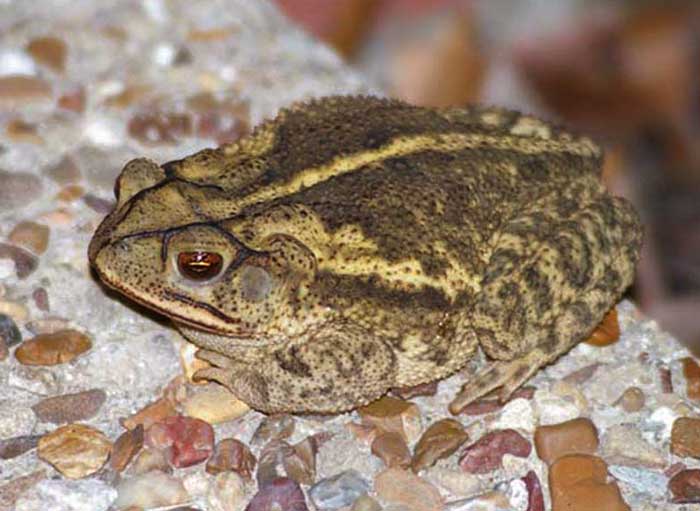
This toad is relatively flat and measures 2 to 4 inches long from snout to vent.
Color variation exists between individuals, with most of them generally being dark brown or almost black with deep orange to yellow-brown touches. Whitish spots may also be spotted across the dorsal surface.
A distinct feature of this toad is a dark and broad lateral stripe found on either side, plus a light stripe starting from the head and running down the middle of the back.
An even more distinguishing feature is the prominent cranial crest that creates a deep valley between the toad’s eyes.
The toad has triangular parotid glands connecting to its crest just behind its eyes. Most individuals also feature a distinct, narrow, and dark line running across the length of their upper lips.
Gulf coast toad occurs in a wide variety of habitats including swamps, forests, coastal prairies, and barrier beaches. Moreover, it is common in urban areas and is often spotted in areas such as railroads, roadsides, storm sewers, backyards, irrigation ditches, and gardens.
The toad has adapted quite well to urban settings and can thrive anywhere provided there’s plenty of cover and moisture. During this day, you’ll find this toad taking cover in vegetative debris, concrete slabs, and other types of covers. (Source).
This toad is nocturnal and usually emerges at night to hunt. It feeds on a wide variety of insects and any other arthropods small enough to fit its mouth. It can be spotted near porch lights and streetlights where the flying insects are quite common.
Breeding for this toad starts from March to September and is triggered by rainfall. Males gather around suitable breeding sites, e.g. ponds, roadside ditches, temporary wetlands, and other Stillwater sources.
They make mating calls (short flat trill call that lasts around 2 to 6 seconds repeated several times) to attract females for mating.
Here’s a short video of a Gulf Coast male toad making a mating call:
Video:
Following successful mating, females lay up to 20,000 eggs, which take 10 days to hatch into tadpoles. Tadpoles then take around 20 to 30 days to metamorphose into juvenile gulf coast toads.
The IUCN Red List currently classifies Gulf Coast toad as a species of Least Concern. It is abundant and widespread throughout its range and considered quite common. It is also not under any federal protection.
Gulf Coast Toad Size
The Gulf Coast toad is a medium-sized species, with adults measuring 2 to 4 inches (5.1 to 10 cm) long. However, females tend to grow larger than males.
Gulf Coast Toad Male or Female
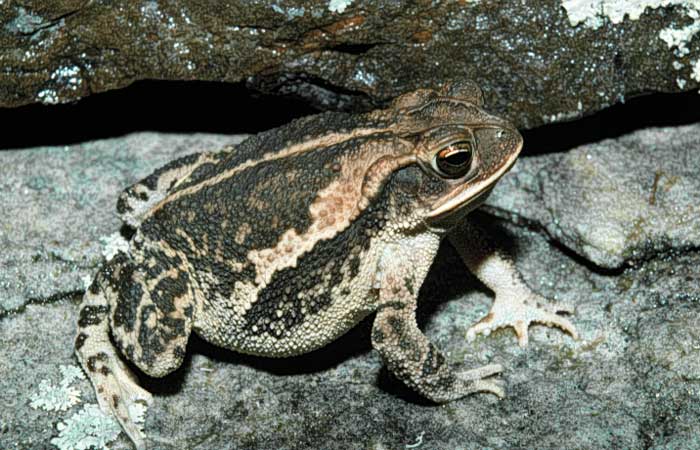
Gulf Coast toad males and females exhibit several distinct differences that make it easy to tell them apart. Some key aspects where these toads differ are discussed below:
- Size: Adult females are generally larger than males. However, this method may be a less accurate way of sexing the toad gender. A toad that’s not fully grown may be misleading in terms of size.
- Throat coloration: Males are set apart from females with their yellow-green throat coloration. Females generally lack any pigmentation around the same area. This is a more accurate sexing method.
Gulf Coast Toad Diet
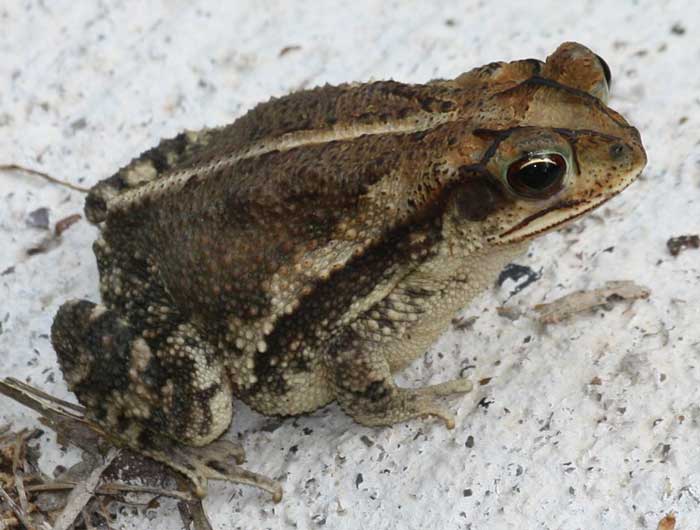
The Gulf Coast toads feed on a wide variety of insects in the wild. It also feeds on any arthropod that’s small enough to fit in its mouth.
Gulf Coast Toad Poisonous Characteristics
Gulf coast toad is poisonous, a characteristic standard of most other true toad species. It comes armed with parotid glands behind its eyes, which release a toxic substance when the toad is threatened or stressed.
This is usually the toad’s mechanism to deter predators from consuming it. Potential symptoms of predators who ingest or come in contact with this substance include nausea, inflammation, and irregular heartbeats. In extreme cases, it can cause death!
So, is the Gulf Coast toad poisonous to dogs? If you’re a pet owner, you may also be wondering whether this toad is poisonous to dogs. The answer is YES. When your dog bites this toad, it releases toxins which are absorbed through the dog’s mucous membrane and into its bloodstream.

Once inside the dog’s system, this toxin can cause a multitude of effects such as increased salivation, panting, trembling, vomiting, “brick-colored” red gums, and quite high irregular heartbeats. It can also cause seizures and even death due to heart failure. (Source).
Keep in mind that the severity of the toxin on your dog depends on the amount of toxin absorbed, contact time, and size of your dog. Smaller dog breeds are usually the most affected.
Overall, pet owners, especially those who reside in areas inhabited by these toads should be careful not to allow interaction between their pets and these amphibians. This is key to ensuring the well-being and safety of your pets.
Gulf Coast Toad Lifespan
Gulf Coast toad has a relatively short lifespan in the wild of around 3 to 5 years.
However, captive-bred and raised Gulf Coast toads have a much longer lifespan of up to 10 years with proper care.
The toad’s longevity in captivity is still subject to various factors including diet, genetics, environment, and exposure to pathogens.
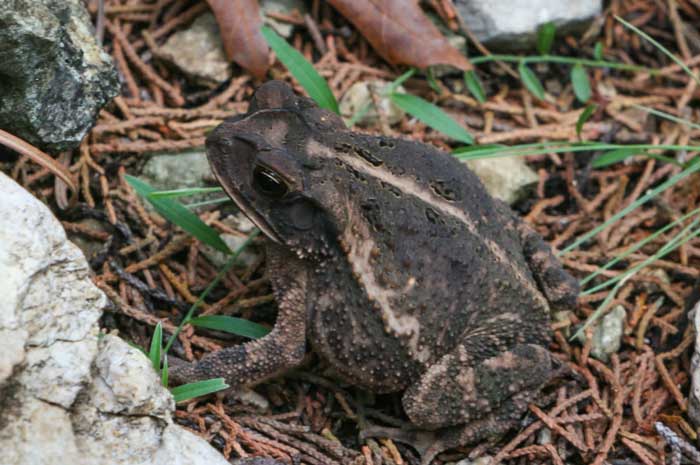
Gulf Coast Toad for Sale (Where to Buy)
The Gulf Coast toad is readily available for the pet trade, so you will have an easy time finding one if you are looking to keep it as a pet.
Some of the avenues to consider when looking for your pet toad include local pet stores, reptile expos, online forums and listings, and specialty reptile/amphibian stores.
In general, we advise you to obtain your pet toad from a reputable breeder who prioritizes the well-being of these animals and adheres to any set legal and ethical standards.
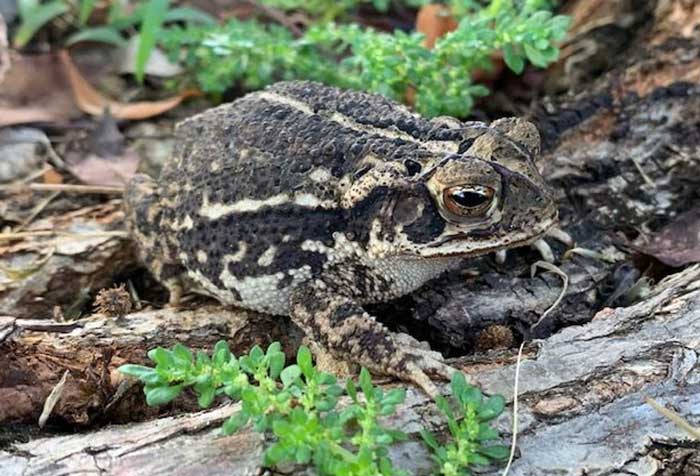
Avoid collecting the toad from the wild as this can affect its wild populations. Plus, it can be an easy way to channel diseases to your home.
Make sure you research this toad’s specific care requirements to ensure you take care of it the right way.
Above all, make sure you comply with your local laws and regulations regarding keeping these toads as pets.
FAQs:
Yes, Gulf Coast toads are venomous. Like most other true toads, they feature parotid glands that secrete a poisonous substance when they are stressed or under threat.
Ingesting or contact with this substance can lead to harmful effects, including on humans and pets.
Exposure of this toxin to pets such as dogs may also be harmful and can lead to health issues such as seizures, vomiting, drooling, and increased heart rate.
Here are some interesting facts about the Gulf Coast toad:
- Gulf coast toads have been hybridized with the southern toads (Anaxyrus fowleri) but they produced unviable offspring of sterile males. (Source).
- These toads have outlasted many other toad species in Texas, whose populations have dwindled over time following the introduction of fire ants in their habitats.
- The Gulf Coast toads tend to eat insects attracted to the light, hence they are most likely to be found near streetlights or backyard lights.
- The toads are also quite common in urban areas and live in any place with plenty of moisture and cover.
How do you identify a Gulf Coast toad?
You can easily identify a Gulf Coast by looking for the following distinct features:
- Prominent cranial ridges: These cranial ridges are easily notable and extend down the top of the toad’s head. They are situated behind each eye.
- Triangular parotid glands: This is another distinct feature of Gulf Coast toads. The parotids are small and triangular-shaped, appearing on each side of the toad’s neck.
- Distinctive stripes: The toad also features light-colored stripes that run across its back and on each side of its body.
However, keep in mind that there exists great color variation among the Gulf Coast toads. This series of photographs by DFW Wildlife will give you a clear picture of the color variations among different individuals.
Conclusion
The Gulf Coast toad (Incilius valliceps) is a southeastern United States native. It is identified by several distinct features such as triangular parotid glands, distinctive stripes running across its body and on the sides, and a prominent cranial ridge. This toad can live in a wide array of habitats and is even common in urban settings provided it gets plenty of moisture and shelter. This species also releases toxins when under attack. The toxins can have adverse effects on its predators as well as humans and pets.
The toad is quite common and widespread throughout its range in southeastern Mississippi through east-central Texas regions. Its population is stable and it is currently not under any threat or risk of extinction. The IUCN Red List classifies the toad as a species of least concern. When buying this toad for keeping as a pet, be sure to buy from reputable breeders who follow ethical and legal standards that favor the well-being and welfare of the amphibian.

Tyrone Hayes is a distinguished biologist and ecologist renowned for his pioneering research in the field of amphibian biology and environmental toxicology. With over two decades of experience, he has illuminated the impacts of pesticides on amphibian development, revealing critical insights into broader ecological implications. Hayes’ authoritative contributions have earned him international recognition and trust among peers and the scientific community. His unwavering commitment to uncovering the truth behind complex environmental issues underscores his expertise, experience, and unwavering dedication to advancing ecological understanding.
